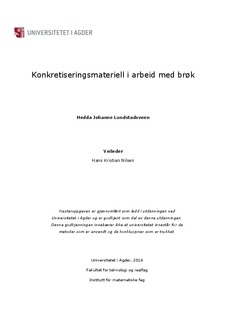| dc.description.abstract | Fractions are a complex concept, and many students struggle in their first approach with it. In this study I have considered how 8th grade students used concrete materials in relation to their work with fractions, in light of the socio-cultural perspective of learning. This study was based on this research question:
How do students in 8th grade perceive the concept of fraction through the use of concrete materials when solving tasks?
To answer this research question, the use of concrete materials was considered with respect to how this contributed to the students' perception of the different aspects related to fractions: fraction as a part of a whole, fraction as measurement, fraction as division, fraction as operator, fraction as ratios. To answer the research question I used a qualitative approach in the datacollection. Four sessions were observed where the students worked with fractions through the use of concrete materials when solving tasks. In addition, a ten-minute interview was conducted in the end of each session.
To provide a more comprehensive representation of the use of concrete materials when working with fractions, I will describe the five aspects of the fraction concept. In addition, the theoretical framework consists of previous research on concrete materials, and it also includes a description of the sociocultural perspective of learning. The analysis is based on this perspective through the student’s cooperation in tasks.
The concrete materials contributed to visualize abstract relations about the different perceptions of the fraction concept, but the way that the tasks were designed also affected what perception the students got. The main finding of the study was what perception the students perceived through the use of different concrete materials. The student’s perception could be divided into three main categories:
1. The perception of fraction as part of a whole
2. The perception of fraction as measurement
3. The perception of a fraction as a division and as an operator
In several cases different perceptions occurred in the same task, and this was related to the way the tasks were designed. They affected which perception the students got. The use of concrete materials in working in groups revealed that the students either had a perception of a fraction, or got a perception of a fraction, or discovered that they lacked or had a misapprehension in their perception of a fraction. Finally, it was also an important finding that the concrete materials needed a clear goal and a direct purpose when using them, so that the students would be able to utilize them in solving tasks. | nb_NO |
